Introduction – Light is a form of energy that gives a sense of vision. Light helps in viewing any object when in returns back from that (reflection of light) to our eyes. We see the objects when the light lights up them. The study of light and its phenomena is called ‘optics’.
e. g.- We see the pen because the light falling on the pen is reflected back to our eyes.
e. g.- When light enters from a ventilator of a dark room, we see the dust particles of air.
What makes Things visible? – We see any object through our eyes when light from that object enters our eyes. This light is either emitted or reflected from that object. Reflection of light is change in direction of light by any reflective surface.
Reflection of light and laws of reflection-The change in direction of light by any reflective surface is called reflection of light. The reflective surfaces or reflective objects are- mirrors, polished wood, metal sheet etc. Other surfaces and objects reflect the light comparatively less.
The light coming out of a torch is a beam of light. The beam of light is made up of light rays. Simply, a narrow beam of light is called as ray. When a light ray falls on a reflective surface like mirror, it gets reflected in other direction with some angle. The light ray that strikes any surface is called the incident ray. The ray that comes out from the surface after reflection is called reflected ray. An imaginary line at 90 ˚ angle is called as normal or perpendicular at the point of incidence of light. The point of incidence is the point where incident ray strikes.
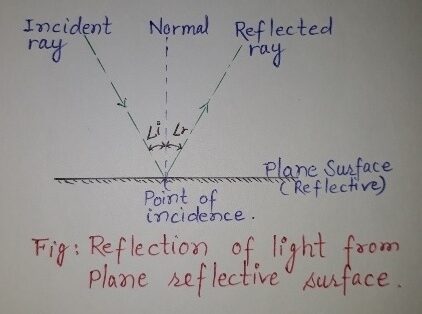
There are two laws of reflection of light-
(a) The angle of incidence ( i) is always equal to the angle of reflection ( r).
(b) The incident ray, the normal at the point of incidence and the reflected ray all lie in the same plane.
Image formation by Plane mirror- The image formed by a plane mirror is an example of reflection of light. The image is an optical phenomenon of representing the object by reflection through mirror or by refraction through lens.
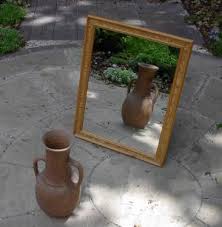
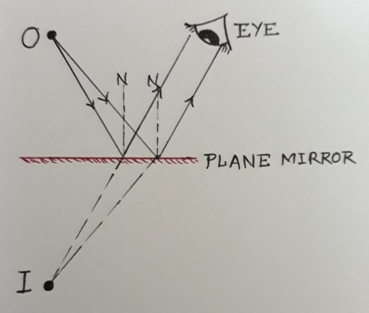
Following are the characteristics of image formed by a plane mirror-
(i) The image is upright.
(ii) The size of image is equal to the size of object.
(iii) The image is formed behind the mirror i.e. the image is virtual.
(iv) The distance of image from the mirror is equal to the distance of object from the mirror.
(v) The image cannot be touched.
(vii) The image cannot be obtained on the screen.
(vii) The image is laterally inverted i.e. left part of image is right part of object and vice versa.
Regular and Diffused Reflection-
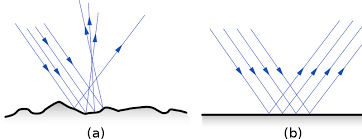
Fig.1 Diffused reflection of light Fig.2 Regular reflection of light
Look at the two above figures. They are reflections from the reflective surfaces. Black coloured rays show the incident rays while the blue coloured rays show the reflected rays. The reflection of light can be-
(a) Regular reflection of light- The regular reflection of light occurs on the plane (or smooth or regular or even) reflective surface. In this type of reflection, the laws of reflection of light are followed.
(b) Irregular or diffused reflection of light- This type of reflection of light occurs on the diffused (or irregular surface or rough or uneven) surface. In this type of reflection, the laws of reflection of light fail.
Reflected Light can be reflected again-
We see the objects when light reaches to our eyes after reflection. But, this light can be reflected again.
e. g.-In the periscope, the light is reflected two times to reach our eyes.
e. g- In the hair dresser shop, the two plane mirrors inclined at some angle reflect the light again and again. So, we see numerous images of ours.
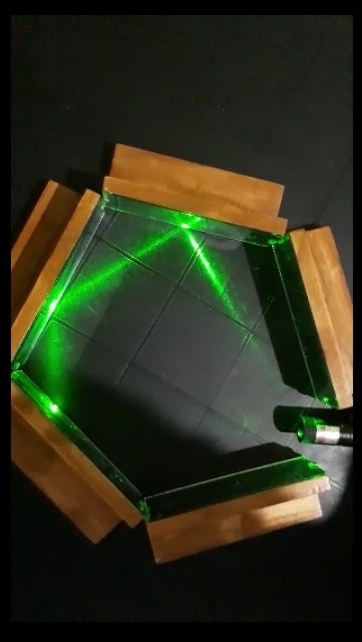
Fig. Re-reflection of light by mirrors
Multiple images-
When two plane mirrors are facing each other and inclined at an angle, a number of images can be formed. The numbers of images formed by two inclined plane mirrors depend on the angle between them.
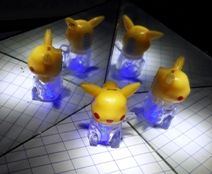
Fig. Multiple image formation by inclined plane mirrors
The number of images can be found by the formula-
n=360˚/θ – 1
Where, n= Number of images
Θ= Angle between plane mirrors
| S.N. | Angle between two plane mirrors | Number of Images formed |
| 1 | 30˚ | 11 |
| 2 | 45˚ | 7 |
| 3 | 60˚ | 5 |
| 4 | 90˚ | 3 |
| 5 | 120˚ | 2 |
| 6 | 180˚ | 1 |
| 7 | 360˚ | 0 |
| 8 | 0˚(Parallel) | ∝ (Infinite) |
Kaleidoscope- Kaleidoscope is a toy based on multiple reflection of light. In it three rectangular mirror strips (15 cm x 4 cm) are used. The reflective surfaces of the mirrors remain inside and they are inclined at 60˚ with each other. The one open end is closed with a translucent sheet or ground glass plate and other end works as an eye –piece. The eye piece end may be covered with a transparent piece of glass of plastic sheet. Inside it small colorful objects like pieces of bangles are placed. On rotation and observation multiple images form beautiful symmetrical patterns inside it. The patterns formed in it are never same.
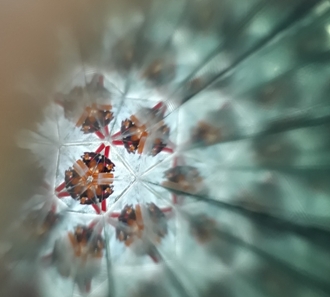
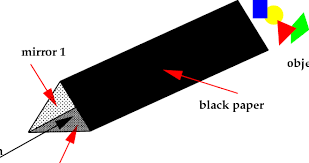
Steps in construction of kaleidoscope-
1. Take three rectangular plane mirror strips (15 cm x 4 cm). Size of mirror strips may vary.
2. The three plane mirror strips are ties with the help of cello tape as like the reflective surfaces of the mirrors remain inside and they are inclined at 60˚ with each other.
3. The one open end is closed with a translucent sheet and other end contains an eye –piece. Inside it small colorful objects like pieces of bangles are placed. These colorful pieces of bangles are kept towards the translucent sheet end side.
Dispersion of white light by prism– The sunlight or white light consists of seven colours. When the sunlight passes through a prism, it splits in seven colours. This phenomenon is called as dispersion of light. The seven colours seen on the white screen are violet, indigo, blue, green, yellow, orange and red. It is commonly called as spectrum and colours as VIBGYOR. The seven colours in the spectrum are not very distinct but overlap each other.
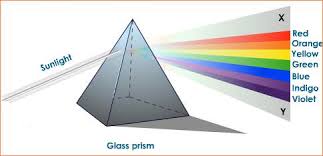
Prisms Spectrum of White light (Source: Wikipedia image)
Human Eye– Eye is a sense organ that helps in vision. The structure and working of human eye helps in understanding the components of eye and how image is formed.
The eye is roughly spherical in shape. The outer layer of eye called sclera is white in colour. The front transparent part of sclera is called as ‘cornea’. Behind the cornea, a colour muscular structure called ‘iris’ is found. Iris gives the distinctive colour to the eye like- black, brown, green and blue coloured eyes. There is a central opening in the iris called as ‘pupil’. The size of pupil is controlled by the iris to allow the light to enter in the pupil.
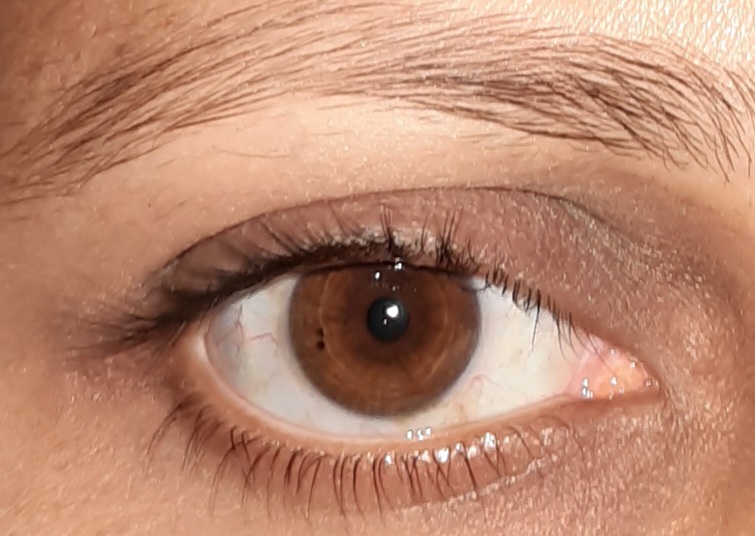
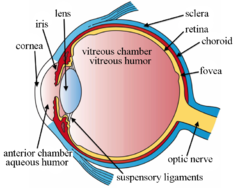
Behind the pupil there is a lens. It is thicker in the middle and thinner at the ends as like a convex lens. It focuses the light from the object on a layer called retina. There are two chambers in the eye in which some solutions are found-
(a) Anterior chamber- which is filled with aqueous humor, and
(b) Posterior Chamber-which is filled with vitreous humor.
The normal lens focuses the image on the retina. The place where image is formed is called as yellow spot or fovea. Retina is the inner layer of eye ball. In retina nerve cells are found which transmit the sensation into brain through optic nerves. The brain analyses the image and we recognize the object. There are two types of nerve cells in the retina- (a) Rods cells- They are sensitive to dim light. About 92 million rod cells are found in human retina.
(b) Cone cells- They are sensitive to bright light and help in sensing of different colours. About 4.5 million cone cells are found in the retina.
At the junction point of retina and optic nerve, no image is formed because no nerve cells are found. This is known as blind spot.
Defects of eyes– The normal eye is able to see the objects distinctly situated close or far away. The minimum distance of distinct vision is 25 cm. approximately. The common defects in human eye are-
(a) Myopia or Shortsightedness or Nearsightedness- In this defect the person can see the close situated objects clearly but cannot see clearly the distant situated objects. In this defect image is formed before the retina. To correct this defect concave lens is advised.
(b) Hypermetropia or Longsightedness or Farsightedness – In this defect the person can see the distant situated objects clearly but cannot see clearly the close situated objects. In this defect the image is formed behind the retina. To correct this defect convex lens is advised.
(c) Cataract-During old age the eyesight becomes less and looks blur due to becoming of lens cloudy. This can be corrected by removing the lens by surgery and replacing it by artificial lens.
Persistence of vision- The impression of image formed on retina lasts for 1/16 of a second. So, if still images of a moving object are flashed on eye at a rate faster than 16 per second, the eye perceives this object as moving. This phenomenon is called as persistence of vision. In movies a number of separate pictures in a proper sequence are shown to move in front of eye at a rate of 24 per second. So, we see a moving picture.
Its knowledge is important in photography and film making.
Mosaic vision of compound eyes- The eye of some insects like butterfly are comparatively large. They are made up of thousands of little eyes, therefore, called as compound eye. Their vision is called as mosaic vision. They can see front side, sides as well as back side. Butterflies can see the ultraviolet rays through their eyes.
Vision in birds- The day birds like parrot, crow, eagle, kite etc can see very well during day but not during night. They have more cones and fewer rods in their retina. The night birds like owls have large cornea and pupil to allow sufficient light to see in night. They have more rods and fewer cones in their retina. Owls can rotate their head upto 270 degree.
Care of Eyes- The eyelids of eye protect the eye from entering of any object. The eyelid shut to stop the entering of light if not required. However, we should take care to our eyes.
1. Only on advice of doctor use the spectacles.
2. Too little or too much lights are harmful for eyes. In insufficient light eyestrain and headaches are caused. Excess light like sunlight, very bright lamp light or laser torch light can injure the retina.
3. Do not look at the sun and powerful light sources directly.
4. Never rub your eyes. If any particle of dust goes into the eyes, wash the eyes with clean water. If there is no improvement go to doctor.
5. Reading of should be done at a normal distance. Do not read by bringing the book too close or keeping it too far.
6. Wash your eyes frequently with clean water.
Braille System– The loss of vision may be since birth or after birth. Such visually challenged persons develop their other senses more sharply. One of the greatest invention for visually challenged persons by Louis Braille in 1821, who himself was a visually challenged person. He developed a system of 63 embossed symbols/ dot patterns/characters. The dot patterns are arranged in cells of two vertical rows of three dots each. These are used to prepare the words, sentences in common languages, mathematics and scientific notions. The patterns have to be learnt and memories to understand it. These dots can be written by hands using Braille slate and stylus, type- writer machine and softwares which convert languages into Braille.
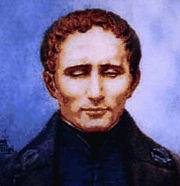
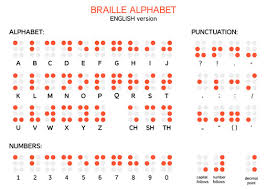
Helen A keller, Ravindra Jain , Stevie Wonder etc are exemplary visually challenged people who
Inspired and set examples for others.
EXERCISE QUESTIONS-
Q.1. Suppose you are in a dark room. Can you see objects in the room? Can you see objects outside the room? Explain
Ans- The eye does not have a sense of vision in absence of light. So, we cannot see in dark. To see an object either light should be released or reflected from it.
Outside the room there is light which reflects from the non-luminous objects and reach to our eyes. So, we can see them.
Q.2 Differentiate between regular and diffused reflection. Does diffused reflection means the failure of the laws of reflection?
Ans-
| S.N. | Regular Reflection | Diffused reflection |
| 1. | The incident rays and reflected rays are parallel to each other. | The incident rays and reflected rays are not parallel to each other. |
| 2. | It occurs due to plane reflective surface. | It occurs due to irregular reflective surface. |
| 3. | The reflected rays get reflected in a particular direction. | The reflected rays get reflected in different directions. |
| 4. | Image formed by regular reflection is sharp and clear. | Image formed by diffused reflection is not very clear and sharp. |
Q.3 Mention against each of the following whether regular or diffused reflection will take place when a beam of light strikes. Justify your answer in each case.
(a) Polished wooden table
(b) Chalk powder
(c) Cardboard surface
(d) Marble floor with water spread over it.
(e) Mirror
(f) Piece of paper
Ans-
(a) Regular reflection- Polished wooden table acts as a plane and shiny surface.
(b) Diffused reflection –Chalk powder acts as irregular surface for reflection
(c) Diffused reflection – Cardboard surface acts as irregular surface for reflection
(d) Diffused reflection- Marble floor with water spread over it acts as medium for reflection and refraction.
(e) Regular reflection – The smooth surface will cause regular reflection.
(f) Diffused reflection- act as irregular surface for reflection
Q.4 State the laws of reflection.
Ans- There are two laws of reflection of light-
(a) The angle of incidence ( i) is always equal to the angle of reflection ( r).
(b) The incident ray, the normal at the point of incidence and the reflected ray all lie in the same plane.
Q.5 Describe an activity to show that the incident ray, the reflected ray and the normal at the point of incidence lie in the same plane.
Ans- Requirements- Plane Mirror, Torch light or Laser light and white paper sheets
When a light ray falls on a reflective surface like mirror, it gets reflected in other direction with some angle. The light ray that strikes any surface is called the incident ray. The ray that comes out from the surface after reflection is called reflected ray. An imaginary line at 90 ˚ angle is called as normal or perpendicular at the point of incidence of light. The point of incidence is the point where incident ray strikes.
The incident ray, the normal at the point of incidence and the reflected ray all lie in the same plane.
Q.6 Fill in the blanks in the following.
(a) A person 1 m in front of a plane mirror seems to be ……….m away from his image.
(b) If you touch your………ear with right hand in front of a plane mirror it will be seen in the mirror that your right ear is touched with ……………..
(c) The size of the pupil becomes ……..when you see in dim light.
(d) Night birds have …….cones than rods in their eyes.
Ans-
(a) 2
(b) right, left hand
(c) large
(d) lesser
Choose the correct option in Questions 7-8
Q.7 Angle of incidence is equal to the angle of reflection.
(a) Always (b) Sometimes
(c) Under special conditions (d) Never
Ans-(a) Always
Q.8 Image formed by a plane mirror is –
(a) Virtual, behind the mirror and enlarged
(b) Virtual, behind the mirror and of the same size as the object
(c) Real at the surface of the mirror and enlarged
(d) Real, behind the mirror and of the same size as the object.
Ans-(b) Virtual, behind the mirror and of the same size as the object
Q.9 Describe the construction of a kaleidoscope.
Ans- Steps in construction of kaleidoscope-
1. Take three rectangular plane mirror strips (15 cm x 4 cm). Size of mirror strips may vary.
2. The three plane mirror strips are ties with the help of cello tape as like the reflective surfaces of the mirrors remain inside and they are inclined at 60˚ with each other.
3. The one open end is closed with a translucent sheet and other end contains an eye –piece. Inside it small colorful objects like pieces of bangles are placed. These colorful pieces of bangles are kept towards the translucent sheet end side.
Q.10 Draw a labeled sketch of the human eye.
Ans-
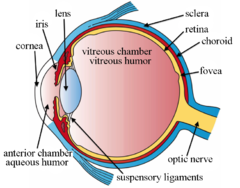
Q.11 Gurmit wanted to perform Activity 16.8 using a laser torch. Her teacher advised her not to do so. Can you explain the basis of the teacher’s advice?
Ans- Rays coming out of laser torch are very powerful. It can damage the retina of Gurmit’s friend’s eye.
Q.12 Explain how you can take care of your eyes.
Ans- Following are the methods to take care of eyes-
1. Only on advice of doctor use the spectacles.
2. Too little or too much lights are harmful for eyes. In insufficient light eyestrain and headaches are caused. Excess light like sunlight, very bright lamp light or laser torch light can injure the retina.
3. Do not look at the sun and powerful light sources directly.
4. Never rub your eyes. If any particle of dust goes into the eyes, wash the eyes with clean water. If there is no improvement go to doctor.
5. Reading of should be done at a normal distance. Do not read by bringing the book too close or keeping it too far.
6. Wash your eyes frequently with clean water.
Q.13 What is the angle of incidence of a ray if the reflected ray is at an angle of 90˚ to the incident ray?
Ans-Angle of incidence= 90˚/2= 45˚
Q.14 How many images of a candle will be formed if it is placed between two parallel plane mirrors separated by 40 cm?
Ans- ∝ (Infinite) number of images will be formed.
Q.15 Two mirrors meet at right angles. A ray of light is incident on one at an angle of 30˚ as shown in fig. 16.19. Draw the reflected ray from the second mirror.
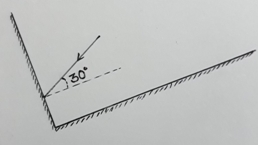
Ans-
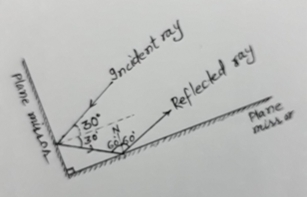
Q.16 Boojho stands at A just on the side of a plane mirror as shown in figure. Can he see himself in the mirror? Also can he see the image of objects situated at P, Q and R?
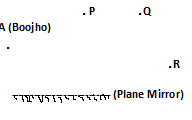
Ans-Boojho is standing just outside the plane mirror. So, he will not be able to see his own image. He can see the image of objects at P and Q but not the image at R.
Q.17 (a) Find out the position of the image of an object situated at A in the plane mirror, as shown in figure.
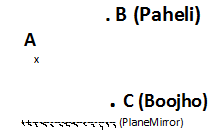
(b) Can Paheli at B see this image?
(c) Can Boojho at C see this image?
(d) When Paheli moves from B to C, where does the image of A move?
Ans- (a) The image will be at same distance behind the mirror as the distance of object is from the mirror.
(b) Yes, Paheli at point B can see the image.
(c) Yes, Boojho at point C can see the image.
(d) No, the image of Object at point A will not move even if Paheli is moving from B to C.
§§§§
<script async src="https://pagead2.googlesyndication.com/pagead/js/adsbygoogle.js?client=ca-pub-7606197531762322"
crossorigin="anonymous"></script>
